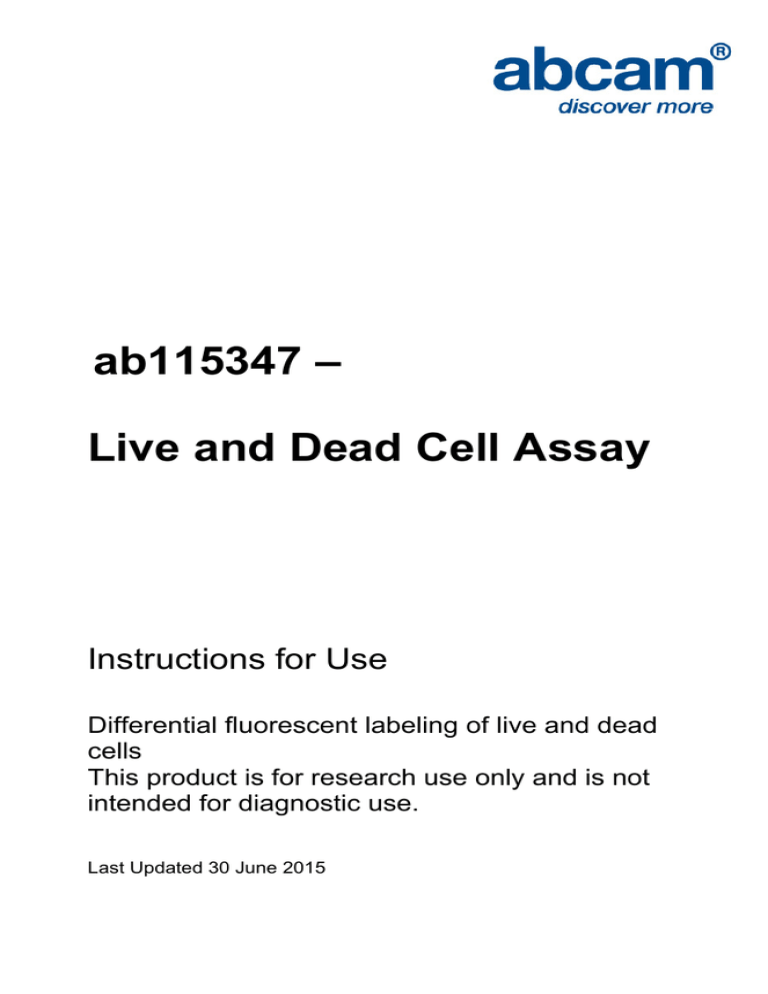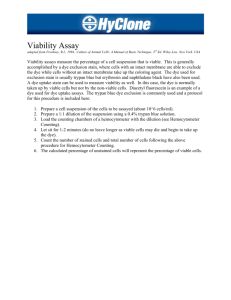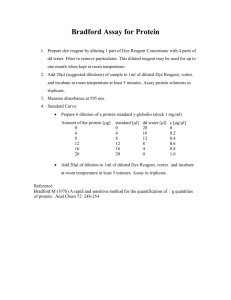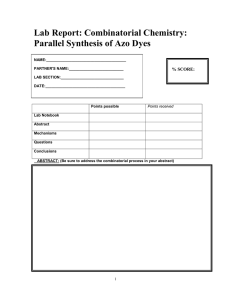
ab115347 –
Live and Dead Cell Assay
Instructions for Use
Differential fluorescent labeling of live and dead
cells
This product is for research use only and is not
intended for diagnostic use.
Last Updated 30 June 2015
1
Table of Contents
1.
Introduction
3
2.
Assay Summary
5
3.
Kit Contents
6
4.
Storage and Handling
6
5.
Additional Materials Required
6
6.
Assay Procedure
7
7.
Sample Data
12
2
1. Introduction
Cell viability is an important component of any in-vitro cell based
assay. Culture conditions and experimental treatments can affect
cell viability by directly or indirectly inducing cytotoxicity, apoptosis
and/or necrosis. Cell viability itself can be an important experimental
endpoint. In addition, it is important to be cognizant of cell viability
when interpreting any experimental results since low cell viability can
confound data interpretation.
A hallmark of viable cells is an intact plasma membrane and
intracellular enzymatic activity. These two features form the basis of
this Live and Dead Cell Assay. Live cells are identified on the basis
of intracellular esterase activity (generating green fluorescence) and
exclusion of the red dye. Dead cells are identified by the lack of
esterase activity and non-intact plasma membrane which allows red
dye staining
Protocols and sample data are included below for flow cytometry and
fluorescent microscopy analysis of cell viability.
Principle: ab115347 is a one-step assay to differentially label live
and dead cells with fluorescent dyes.
It is useful for the rapid
quantitation of cell viability using flow cytometery or fluorescent
3
microscopy. The provided Live and Dead Assay stain is sufficient for
~1000 assays.
The Live and Dead assay stain solution is a mixture of two highly
fluorescent dyes that differentially label live and dead cells:
The Live cell dye labels intact, viable cells green.
It is
membrane permeant and non-fluorescent until ubiquitous
intracellular esterases remove ester groups and render the
molecule fluorescent. The Excitation (max) and Emission
(max) are 494nm and 515nm, respectively (similar to FITC).
The Dead cell dye labels cells with compromised plasma
membranes red. It is membrane-impermeant and binds to
DNA with high affinity.
Once bound to DNA, the
fluorescence increases >30-fold. The Excitation (max) and
Emission (max) are 528nm and 617nm, respectively.
The Live and Dead Cell Assay is a one-step staining procedure that
is simple and fast. It can be used directly in cell culture media.
Stained cells are not compatible with fixation.
4
Limitations:
FOR RESEARCH USE ONLY. NOT FOR DIAGNOSTIC
PROCEDURES.
Do not mix or substitute reagents from other lots or sources.
Any variation in operator, pipetting technique, incubation
time or temperature, and kit age can cause variation in
binding.
2. Assay Summary
Culture (and treat) cells as desired
Label cells with the Live and Dead Dye
Add 1X Live and Dead Dye to cells
(e.g. mix 2X dye in PBS 1:1 with cells in culture media )
Incubate 10 min at room temperature
Analyze cells by flow cytometry or fluorescent microscopy
LIVE: Emission (max): 495nm, Excitation (max): 515nm
DEAD: Emission (max): 528nm, Excitation (max): 617nm
5
3. Kit Contents
1000X Live and Dead Cell stain in DMSO : 0.1 mL
4. Storage and Handling
Store the Live and Dead staining solution at -20°C. Avoid multiple
freeze-thaw cycles. Allow the product to warm to room temperature
before opening.
Use diluted solutions of Live and Dead stain
promptly.
5. Additional Materials Required
Flow
cytometer
(required
and/or
fluorescence
excitation/emission
microscope
wavelengths
495nm/515nm and 528nm/617nm)
General tissue culture supplies
PBS – sterile (1.4 mM KH2PO4, 8 mM Na2HPO4, 140
mM NaCl, 2.7 mM KCl, pH 7.3)
6
6. Assay Procedure
For Flow Cytometry analysis:
1. Culture cells normally.
2. Generate single cell suspension.
a. For suspension cell lines, gently pipette up and
down to dissociate any cell aggregates.
b. For adherent cell lines, trypsinize cells to dissociate
from plate and quench with media.
3. Stain cells with the Live and Dead Dye diluted to 1X
concentration.
a. Dilute Live and Dead Dye to 2X concentration in
PBS. E.g. 1mL PBS + 2µL 1000X Live and Dead
Dye.
b. Mix equal volumes of single cell suspension and 2 X
Live and Dead Dye solutions. E.g. 50µL cells + 50µL
2X dye; resulting Live and Dead Dye is 1X
concentration.
4. Incubate cells for 10min at room temperature in the dark.
5. Analyze cells by flow cytometry.
7
a. Both dyes are excited by the 488nm laser and can
be detected with 530/30 and 670LP detectors (as
shown below).
b. Establish Forward and Side Scatter gates to exclude
debris.
c.
Establish a green dye vs. red dye dot plot (typically
FL1 vs. FL3) to analyze live and dead cells. The
sample dot plots below demonstrate varying ratios
of live and dead cells.
Live
Live
96%
Live
79%
4%
Dead
36%
21%
Dead
64%
Dead
6. Use a healthy cell population to draw a diagonal gate along
the lower right border of live (green) cells.
More green = upper left = live cells; more red = lower right =
dead cells.
8
For fluorescent microscopy analysis:
1. Culture cells normally.
a. For adherent cells: Culture cells on surface that is
compatible with the available imaging system (e.g.
coverslip, chamber slides, clear-bottom optical multiwell plates, etc).
b. For suspension cells or adherent cells that have
been converted to a single cell suspension by
trypsinization: Follow the steps above to stain cells
for flow cytometry. At step 5, pipette a small volume
(e.g. 5-10µL) of the cell suspension onto a slide and
cover with a glass coverslip. Image immediately.
c.
It may be necessary to concentrate the cells in the
staining
solution
centrifuging
cells
before
and
imaging
removing
by
90%
gently
of
the
supernatant. Gently resuspend the cell pellet in the
remaining solution and transfer to the slide.
d. Typically microscopy requires the Live and Dead
Assay Stain to be used at 5X concentration instead
of 1X. See note in Step 2b below.
2. Stain cells with the Live and Dead Dye
a. Dilute Live and Dead dye in PBS and overlay to
cells in media to a final dye concentration of 5X.
9
Alternatively, to conserve the amount of dye used, it
may be preferable to aspirate media and add 5X dye
in PBS directly to cells.
b. Fluorescent microscopy imaging of the Live and
Dead dye may require staining with a higher
concentration of the dye. Using a 5X dye solution is
the recommended starting concentration and users
should determine the optimal dye dilution based on
the cell lines used and imaging systems available.
3. Image cells.
a. Green = live cells; Red = dead cells. See Figure 1
below.
ADDITIONAL GUIDELINES:
1. The Live and Dead Dye is provided at 1000X.
We
recommend using it at 1X concentration for flow cytometry
analysis and at 5X for fluorescent microscopy. Users should
determine the optimal staining intensity for individual cell
lines and equipment used.
2. There is flexibility in how the dye is added to cells.
For
example, a 2X solution of dye in PBS can be mixed 1:1 with
cells in culture media. Another option is make one volume
of 10X dye and add 9 volumes of cells in culture media.
Alternatively, 1 volume of cells could be added to 9 volumes
of 1.1X dye in PBS.
10
3. For uniform staining it is important that the dye is mixed well
with the cells.
For this reason it is not recommended to
pipette directly 1000X dye to a cell solution. It is preferable
that the dye is first pre-diluted in PBS and then further
diluted 2 to 10-fold into the cell solution. Dye should be
used promptly after dilution.
4. It is recommended to analyze the cells as quickly after
staining as possible. The staining solution should not be
exchanged for another buffer before data acquisition.
Stained cells are stable for at least one hour at room
temperature after staining. Live and Dead dye staining is
lost if cells are fixed.
11
7. Sample Data
Live and Dead assay by fluorescent microscopy:
A
B
Figure 1. Jurkat cells stained with the live and dead assay kit.
Jurkat cells treated with Etoposide were labeled with the live and
dead assay stain. Live cells (with esterase activity) stain green and
dead cells (compromised plasma membrane) stain red. (A) Field of
cells following 10 minute staining in media of live and dead stain. (B)
Magnified view showing that in live cells the whole cell is stained
green whereas in dead red cells it is the fragmented nuclear DNA
that is stained.
12
Live and Dead assay by flow cytometry:
A
A
Vehicle
250nM Etoposide
1000nM Etoposide
4000nM Etoposide
Vehicle
250nM Etoposide
1000nM Etoposide
4000nM Etoposide
B
B
13
Figure 2.
Flow cytometry analysis using the Live and Dead
assay stain.
Jurkat cells were treated with a dose response of
Etoposide on day 0 and analyzed using the live and dead assay
stain on days 1, 2 and 3 using flow cytometry. At each time point a
small aliquot of cells was removed from the culture for analysis. (A)
Dot plots showing live and dead analysis of day 3 samples. Live
cells are on the y-axis and dead cells are on the x-axis. The red
polygon gate identifies live cells and the number indicates the
percent of live cells.
(B)
Graphical representation of the data
presented in (A) with additional time points.
% viable cells are
plotted relative to time, with respect to Etoposide concentration.
14
UK, EU and ROW
Email: technical@abcam.com | Tel: +44(0)1223-696000
Austria
Email: wissenschaftlicherdienst@abcam.com | Tel: 019-288-259
France
Email: supportscientifique@abcam.com | Tel: 01-46-94-62-96
Germany
Email: wissenschaftlicherdienst@abcam.com | Tel: 030-896-779-154
Spain
Email: soportecientifico@abcam.com | Tel: 911-146-554
Switzerland
Email: technical@abcam.com
Tel (Deutsch): 0435-016-424 | Tel (Français): 0615-000-530
US and Latin America
Email: us.technical@abcam.com | Tel: 888-77-ABCAM (22226)
Canada
Email: ca.technical@abcam.com | Tel: 877-749-8807
China and Asia Pacific
Email: hk.technical@abcam.com | Tel: 108008523689 (中國聯通)
Japan
Email: technical@abcam.co.jp | Tel: +81-(0)3-6231-0940
www.abcam.com | www.abcam.cn | www.abcam.co.jp
15
Copyright © 2014 Abcam, All Rights Reserved. The Abcam logo is a registered trademark.
All information / detail is correct at time of going to print.







